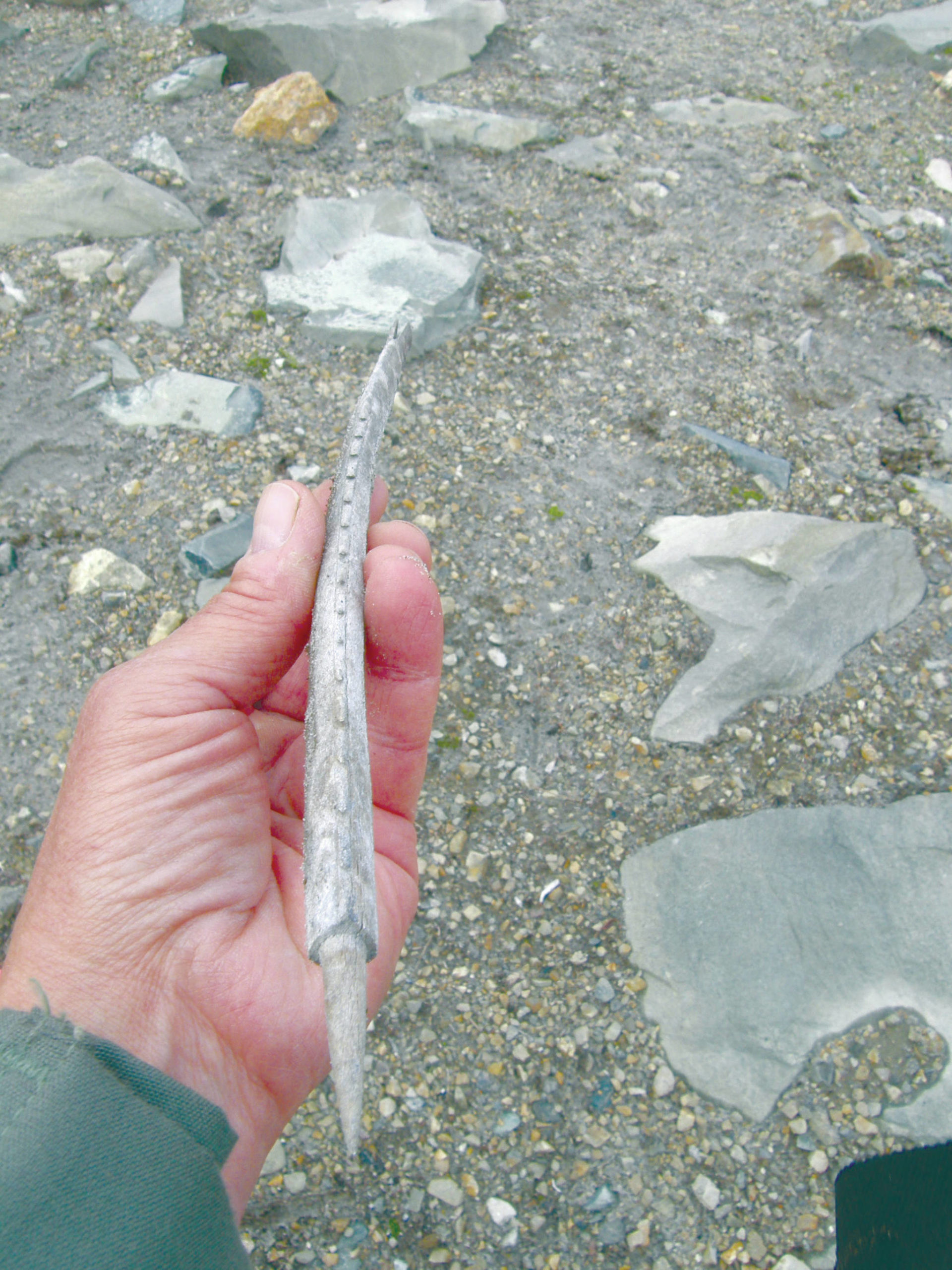Alaska’s mountains and glaciers are beautiful to observe, and many of us enjoy summertime hikes and backpacking among the peaks. Some hardy individuals even undertake winter forays to the mountains.
The sheer masses of rock and ice can also hold a warning, reminding us how small we are and of the fragility of life in the high alpine environment. At least that’s the feeling I get, hiking and backpacking in the Chugach and Alaska ranges. But it turns out that our snowy mountains also have secrets of human life and history to reveal, frozen in snow and ice.
High-altitude ice and snow patches in mountain ranges around the world are melting. Frozen artifacts, animal carcasses and even human remains are revealed in the melting ice.
Among the objects recovered from ice patches are rare and exceptionally well-preserved artifacts that were used to hunt animals as much as 9,000 years ago. These artifacts, perfectly preserved while frozen in high-altitude snowfields, become fragile and quickly decompose when thawed.
Climate change is accelerating the melting process, and more sites and artifacts are becoming exposed. We are now racing to recover these materials before they are lost forever. As archaeologists, we study these materials and have learned much about how people lived in the past.
Here in Alaska, ice patch artifacts have been discovered in Lake Clark National Park and Preserve, Wrangell-St. Elias National Park and Preserve and elsewhere. The excellent preservation of frozen artifacts provides us with valuable opportunities to observe and study elements of prehistoric technology that do not usually survive erosive processes.
Organic materials, such as wood, bone and antler are normally subject to biological and mechanical processes of decomposition. But when encased in ice and snow, these objects retain amazing qualities of preservation. These artifacts are evidence that people were present in Alaska’s high country in the distant past.
What were ancient people doing high in the mountains?
In Alaska, it all starts with caribou. During the summer months, these migratory herd animals seek out perennial alpine snowfields to escape lowland heat and insects.
In western Alaska, the Mulchatna Caribou Herd ranges widely, from the Bristol Bay lowlands to the mountains north of Lake Clark. Prehistoric hunters — the direct ancestors of today’s Dena’ina peoples — realized that the snow patches were a predictable place to find congregations of caribou and made regular seasonal hunting trips into the mountains.
Other animals, for example sheep, could also be hunted in the high country. During these trips, hunters occasionally lost or left behind hunting implements and other items, which became buried in the snow.
The most common artifacts found at snow patch locations are hunting implements such as arrows and spear points made from organic materials of bone, antler and wood.
Unlike nonorganic materials such as metal, stone and ceramics, organic artifacts can be dated using radiocarbon analysis. Using these techniques, we have determined that people were hunting on Alaska snow and ice patches for thousands of years.
An antler spear point found in Lake Clark National Park and Preserve was dated to approximately 2,000 years ago, while ice patch artifacts from Wrangell-St. Elias National Park and Preserve are even older — more than 3,000 years old. The oldest dates in the region come from the Yukon Territory, where archaeologists found a 9,000-year-old spear shaft.
The discovery of intact hunting weapons provides insights for how people designed, crafted and assembled their tools. By using radiocarbon dating, we can also document shifts in technology.
For example, evidence shows there was a shift in hunting techniques about 1,200 years ago from spears to bow and arrows. Interestingly, we found both arrow and spear points in ice patches in Lake Clark. The arrows were generally tipped with barbed antler or bone points, while some used native copper arrowheads.
The rare artifacts recovered from snow and ice patch locations provide important additional information, since many of these objects retain the materials used for hafting (how a point is fitted into the shaft) and fastening.
Similar materials have been found across a tremendous span of Western North America, from Alaska through the Canadian Yukon, British Columbia and the Rocky Mountain states.
Artifacts recovered from snow and ice patches have greatly helped our understanding of pre-contact life and activity in Alaska and elsewhere. Ice patch hunting was likely part of a broader summer-season resource procurement activity.
Highly mobile bands of people would generally establish a base camp at a mountain lake and make forays for fishing and other activities such as harvesting alpine berries and trapping small mammals like squirrels and marmots.
All members of the group, including children, participated in hunting and gathering. The recently discovered ice patch artifacts attest to the antiquity of activities that continue today.
Jason Rogers is an archaeologist for the National Park Service at Lake Clark National Park and Preserve. Find more Refuge Notebook articles (1999–present) at https://www.fws.gov/refuge/
By JASON ROGERS
National Park Service

